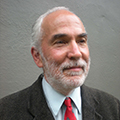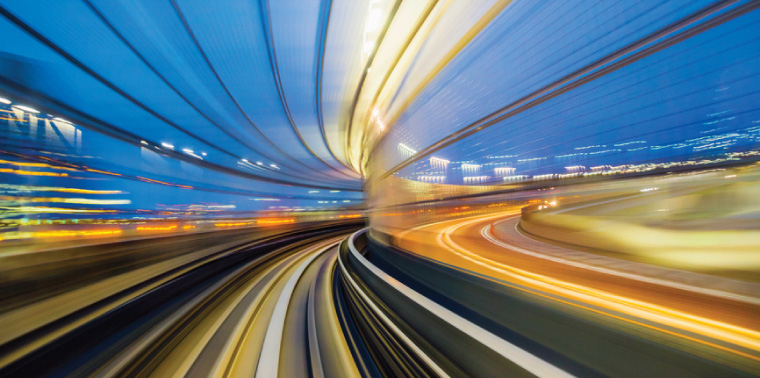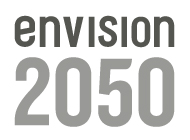March 31, 2014 — What will transportation be like in 2050? Will we all be stuck in one giant traffic jam? Flying to our appointments in personal airborne delivery systems? Teleporting ourselves and our stuff around? Or not going anywhere at all?
In large part, the answers to these questions will depend on how we answer two other questions today: What would we like it to be like? And what would it take to get it there?
In the spirit of expanding our possibilities by proactively imagining a future we really want, Ensia is launching Envision 2050: a series of articles in which experts from around the world describe their ideal for human systems in 2050 and what it would take to get there.
In the first of the series, we asked five innovative thinkers from the U.S. and China to share their visions for transportation in 2050. Here’s what we heard:
Deborah Gordon: Business as Usual
Senior associate with the Carnegie Endowment Energy and Climate Program and co-author of Two Billion Cars: Driving Toward Sustainability
 Yesterday’s transportation revolution never got off the ground. The 1950s were a launchpad for travel by nuclear jetpacks and personal solar helicopters. In the 1960s, George Jetson was commuting in a fab flying saucer. By the 1970s, however, transportation came crashing back to Earth in the context of concerns about finite oil supplies and ongoing skirmishes to claim them.
Yesterday’s transportation revolution never got off the ground. The 1950s were a launchpad for travel by nuclear jetpacks and personal solar helicopters. In the 1960s, George Jetson was commuting in a fab flying saucer. By the 1970s, however, transportation came crashing back to Earth in the context of concerns about finite oil supplies and ongoing skirmishes to claim them.
Both visions — one fueled by post-war optimism and the other by geopolitics that seemed more suited to the pre-war era — appeared to lead to a way forward beyond oil. Reality, however, is shaping up differently than was ever imagined.
It turns out that hydrocarbons are abundant, diverse and buried just about everywhere. The higher the market price, the more rapid the technological breakthroughs and the more accessible resources will become. This in turn will lead to oil, gas and coal more readily being converted into transport fuels and other petroleum products. Envisioning 2050 transportation running on alternatives to oil — conventional wisdom just five years ago — is suddenly far from guaranteed. This is the case even with global transport demand expected to grow by 50 percent and the number of motor vehicles on the road to more than double.
Oil 2.0 has arrived as if by secret drone. What this means for transportation is “business as usual,” unless radical policy shifts meet new market conditions head on.
It is the case, however, that volatile oil prices might just spur vehicle electrification in the future. Today’s cars increasingly resemble computers on wheels, making their transition from oil to electricity much more viable. This wholesale shift to electric vehicles could be transformational, bringing transport into the renewable realm. Quebec, for example, generating electricity with hydropower and without hydrocarbons, could lead the way to a new normal.
Transport is widely expected to be the last sector to wean itself off oil. But as oils get more difficult, dangerous and damaging, the world must be compelled not to repeat the same mistakes.
Circa 2050: It will be time for a real transport revolution.
Feng An: Oil Eliminated
Founder and executive director of the Innovation Center for Energy and Transportation, a China/U.S.-based not-for-profit think tank
 China’s 2050 transportation will have zero tailpipe emissions and be composed of mainly unmanned connected cars. Social status and private mobility will be decoupled, allowing on-demand car sharing and carpooling to dominate private urban commutes. Individuals will be able to quickly order vehicles fitted to their commutes, resulting in limited need for urban parking spaces and blurring the distinction between public and private transport. In between cities, commuter and freight transport will rely mainly on new-energy-powered fast trains and bio-powered airships. International water freight will be dominated by high-speed ships powered through in-seas energy storage stations utilizing wave and solar energy.
China’s 2050 transportation will have zero tailpipe emissions and be composed of mainly unmanned connected cars. Social status and private mobility will be decoupled, allowing on-demand car sharing and carpooling to dominate private urban commutes. Individuals will be able to quickly order vehicles fitted to their commutes, resulting in limited need for urban parking spaces and blurring the distinction between public and private transport. In between cities, commuter and freight transport will rely mainly on new-energy-powered fast trains and bio-powered airships. International water freight will be dominated by high-speed ships powered through in-seas energy storage stations utilizing wave and solar energy.
This vision embodies China’s major policy drivers today: reduce oil dependency, mitigate greenhouse gas emissions and improve air quality while maintaining social stability. Decision makers in China would like to see China’s transport oil consumption eliminated, reduce life-cycle carbon dioxide emissions per unit of distance by 85 percent, and curb inner-city PM2.5 air pollution to zero. Because China’s authorities hold enough regulatory and financial power to ensure market commitment to their directed goals, top-down approaches are of imminent importance.
In order to internalize the vision, national and local policy makers would: 1) steer industrial development, mainly by creating stringent standards and requirements that slowly eliminate combustion-engine-type vehicles’ profitability; 2) allocate and direct financial investments toward new-energy solutions, including global financial mechanisms and investments; and 3) carefully plan cities so that the daily average commute will be reduced to some 2 kilometers. Policy makers would require tailored tools based on global best practices, such as city transport emissions planning tool kits, information disclosure platforms that would reflect market implementation, clear and strict enforcement mechanisms, local pilots for evaluating new schemes and solutions, and cross-sector and multi-stakeholder workshops and roundtables in which problems could be raised and promptly addressed for ensuring smooth development.
Mark Safford: Holodecks, Anyone?
Associate of the Futures Strategy Group and retired planner and analyst for the U.S. departments of Defense, State and Transportation
 Some pundits liken modern transportation to the body’s circulatory system, where transportation arteries carry people and goods around the global body. That’s actually not a bad analogy. The next several decades will likely see an extremely rapid evolution of this system as global technological, population and economic growth all accelerate.
Some pundits liken modern transportation to the body’s circulatory system, where transportation arteries carry people and goods around the global body. That’s actually not a bad analogy. The next several decades will likely see an extremely rapid evolution of this system as global technological, population and economic growth all accelerate.
Assuming, of course, that no extreme unlikely event (meteorite strike, Ice Age return, thermonuclear war, alien visitation, etc.) occurs, the following trends are likely to be seen:
- Telecommunications and cloud computing will replace transportation for moving ideas and intellectual property. Why ship a book or DVD when the content can be digitized and e-mailed instead?
- Instead of moving people to places, places will be created where the people are — but without the bulky visors and electronic gloves associated with virtual reality today. Holodecks, anyone?
- Much effort will go into saving energy, eliminating carbon fuels and minimizing environmental impacts while still meeting growing demand for moving people and things.
- The real issue will be how to meet the above goals while moving a constantly increasing demand for low-value, high-bulk freight — everything from consumer goods, foods and fuels to building materials (wood, stone, sand, gravel, steel, asphalt, etc.), water, and even trash and garbage — for more people who can afford to buy more things. Each person in a modern economy requires thousands of ton-miles of these goods annually.
Being an optimist, I think our species will figure out how to fulfill these goals without destroying civilization on our way to 2050. After all, if we can rebuild and globalize our society after World War II, these challenges should be a snap!
James Lee: Transit Synergized Development
Founder of the iContinuum Group, a planning and design integrated solutions provider in Shanghai, China
 Transit Synergized Development is a strategic model of sustainable urban development targeting the next generation of transit-ready cities in China. TSD is predicated on the integrated planning, development and management of one-square-kilometer districts around mass transit stops, creating energy-efficient, economically vibrant and highly livable urban neighborhoods.
Transit Synergized Development is a strategic model of sustainable urban development targeting the next generation of transit-ready cities in China. TSD is predicated on the integrated planning, development and management of one-square-kilometer districts around mass transit stops, creating energy-efficient, economically vibrant and highly livable urban neighborhoods.
TSD transforms the transit nodes of a city, arguably its socioeconomic centers and energy and resource hot spots, into a network of Energy Hubs, district energy systems that work with the city’s power grid to promote energy efficiency and resilience; a network of Innovation Hubs that collaborate with industries to rapidly prototype new technologies, products and services and promote economic growth; and a network of Social Hubs that foster high-quality urban environments and high quality of life, enhancing the city’s image and attractiveness to businesses and talent.
In targeting the densest and most valuable areas of a city, TSD aims to be largely market-driven, relying on collaboration between private and public sectors as well as innovative institutional and policy mechanisms.
Making TSD a reality will take four types of innovation:
- Policy Innovation: Designate nominal one-square-kilometer districts around transit stops as “Strategic Development Zones,” within which developments must comply with green district and green building standards, including key performance indicators for energy, water, waste and greenhouse gas emissions.
- Planning Innovation: Integrate land use, transit, energy, environment, community and economic planning, creating a new “6-in-1” planning paradigm for smart, low-carbon and green urban neighborhoods.
- Regulatory Innovation: Establish regulatory authority to set district infrastructure guidelines, tariff structure, oversight process and related policies.
- Financing Innovation: Promote public-private partnership mechanisms that foster competition, promote innovation and deliver long-term value to all stakeholders.
By harnessing the synergy that derives from the integration of six impact areas at transit nodes — land use, transportation, energy, environmental, social and economic — and leveraging the transit network to achieve scale, TSD creates a citywide framework for urban transformation.
Jim Motavalli: Just Stay Home
Author of High Voltage: The Fast Track to Plug in the Auto Industry and other books, and a contributor to the New York Times “Automobiles” section
 Transportation is the second-largest source of U.S. greenhouse gas emissions (after power generation), and accounts for 70 percent of all domestic oil consumption. Our cars are big polluters, and 80 percent of people who work outside the home make it worse by driving to work alone. There has to be a better way, and there is.
Transportation is the second-largest source of U.S. greenhouse gas emissions (after power generation), and accounts for 70 percent of all domestic oil consumption. Our cars are big polluters, and 80 percent of people who work outside the home make it worse by driving to work alone. There has to be a better way, and there is.
The simplest and least expensive way to revolutionize our transportation system is a very low-tech solution: Let people telecommute (or at least work staggered hours). Leave your car in the garage just two days a week and you cut your annual carbon dioxide emissions by 1,600 pounds. It seems crazy that in an era when all the high-tech tools of the modern office are available cheaply at home, we still require people to show up for work.
There are huge possibilities here since, in 2011, Americans sat in traffic for 5.5 billion hours, and telecommuting has hit a plateau at just 17 percent of the workforce. The average telecommuter works from home only one day per week. It’s not crazy to think that with a little will and good government/workplace incentives we could triple these numbers by 2050. Half of all jobs are “receptive to telework,” the Atlantic reports, and the rapidly expanding information technology field is especially simpatico.
Sure, there are other worthwhile options, including strengthening public transit and electrifying the transportation fleet. Indeed, sales of plug-in cars doubled from 2012 to 2013. But let’s get real: 96,000 new electric vehicles on the road last year doesn’t have a huge environmental impact in a 15.6 million sales year. And new transit projects face stiff headwinds from huge per-mile costs and political opposition.
Yahoo CEO Marissa Mayer banned telecommuting because she thinks it reduces collaboration, but that flies in the face of many studies to the contrary. Who can deny that working from home increases productivity? After all, you’re replacing a long car ride with walking up or down a set of stairs. ![]()
Ensia shares solutions-focused stories free of charge through our online magazine and partner media. That means audiences around the world have ready access to stories that can — and do — help them shape a better future. If you value our work, please show your support today.
Yes, I'll support Ensia!


You can see it here: http://www.youtube.com/watch?v=evhbUK2EBDc